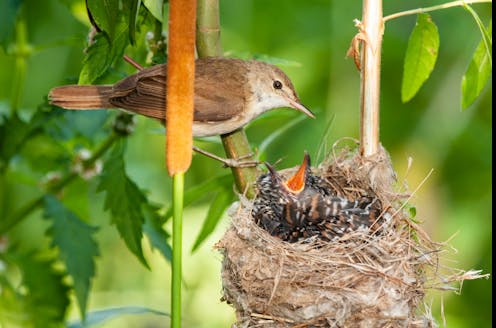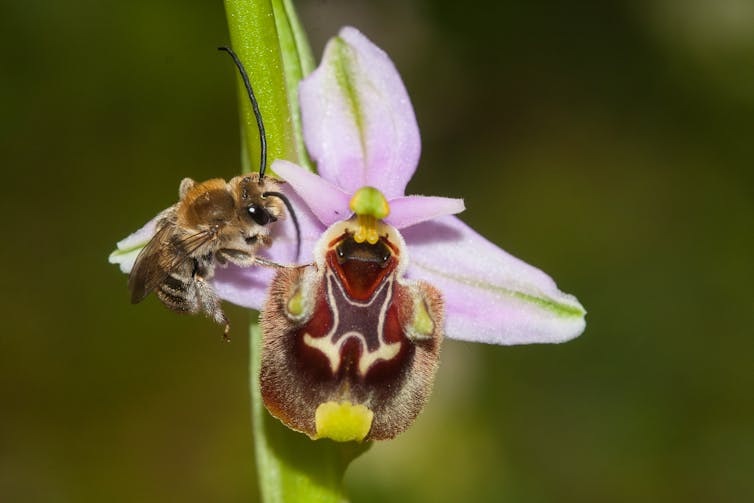
In nature, there are winners and losers. The winners gain survival and reproduction, while the losers generally die. To gain an advantage, winners may adopt strategies that involve elements of dishonesty or deception.
Most people are aware of the cuckoo, a bird that is notorious for its deceptive nature, duping other species such as reed warblers into raising their offspring. The cuckoo and reed warbler is an example of an evolutionary arms race – the species are evolving escalating adaptations to win the war.
Currently, the cuckoo is winning this particular battle. But there is evidence that the reed warblers are fighting back. Research suggests that reed warblers are evolving ways to recognise cuckoo eggs and eject them from their nests.
In the natural world, deception has evolved in many species as a way to increase their success. Here are five species that are currently winning their evolutionary arms races.
1. Bird poo frogs
The bird poo frog Litoria naispela is a tree frog that was recently discovered in Papua New Guinea. This aptly named species is marked with white splatters that resemble bird poo. Unlike camouflage, where organisms blend in with their background, masquerading involves species evolving to look like something else – in this case, an inanimate object that very few things want to eat.
This is not the only species that has evolved to protect itself from predators by looking like poo. Plenty of other frogs and even spiders adopt the same tactic to avoid being eaten.
2. Oriental pratincole
Some species such as the hognose snake often fake death to avert the attention of predators. Others, like the mimic octopus, can even impersonate several dangerous species.
À lire aussi : Some shape-shifting animals that can morph to fool others
By contrast, some animals use themselves as a distraction to lure predators away from their vulnerable offspring. Oriental pratincoles (a bird species native to the warmer parts of south and south-east Asia) often feign a broken wing, presenting themselves as easy targets to tempt predators like birds of prey away from their nests before flying to safety at the last moment.
This deceptive behaviour was previously thought to be restricted to shore birds that nest on the ground. But recent research suggests that it’s more widespread – occurring in nearly 300 bird species.
3. Nursery web spider
Like many invertebrates, the female nursery web spider – named so due to the silk nursery she spins to keep her spiderlings safe – often eats the male after mating to gain vital nutrition to produce eggs. But if the male can survive after mating, he can potentially go on to father more offspring with other females.
So the males often arrive with presents of insects wrapped in silk. While the female is distracted by unwrapping and eating the tasty gift, the male is able to scurry away to safety – it’s a win-win situation.
However, these gifts take time and effort to acquire. So some sneaky males have evolved to give fake gifts of no nutritional value to the female like inedible plant seeds or empty insect exoskeletons. By the time she realises the scam, the male has gone.

4. Bee orchid
Some species even go as far as tricking another species into finding a mate for them. Although some bee orchids are capable of self-fertilisation, reproducing with another plant promotes outbreeding and genetic variety, which is crucial for adapting to changing environments. But as bee orchids aren’t capable of moving across land themselves, they have evolved a tactic whereby one of their petals resembles the female of a solitary bee species.
When the male bee lands on the orchid, believing it to be a female, he attempts to mate with it. During this process, pollen from the orchid gets passed to the male bee. When the bee departs and is fooled again by another orchid, it passes on the pollen from the first plant.
Being specific about what insect visits you is beneficial for the orchid as the bee goes straight to another bee orchid, without stopping to visit other plants and potentially losing the pollen.

5. Alligator snapping turtle
Perhaps the best deceptions have evolved in the fight to acquire food. Many predators are camouflaged so well with their surroundings that it is almost impossible to see them.
If you are a large and slow predator, sitting and waiting for prey is a good strategy. But it can often be futile. So some of the most novel trickery has involved the evolution of a fishing lure.
The tongue of the alligator snapping turtle, a species that sits and waits for prey in murky freshwater habitats in the US, has evolved to mimic a wriggling worm. It acts as bait to attract small fish that the turtle snaps its mouth shut on, then eats.
Humans condemn deception and view it as negative – people want to avoid being duped. But in nature, conning others is instead an essential strategy for organisms to exploit their environments and ensure their survival and reproduction. From the clever mimicry of bird poo frogs and bee orchids to the tactical feigning of injury by the oriental pratincole, these examples demonstrate the extraordinary lengths some species go to guarantee their success.
Louise Gentle works for Nottingham Trent University.
This article was originally published on The Conversation. Read the original article.







